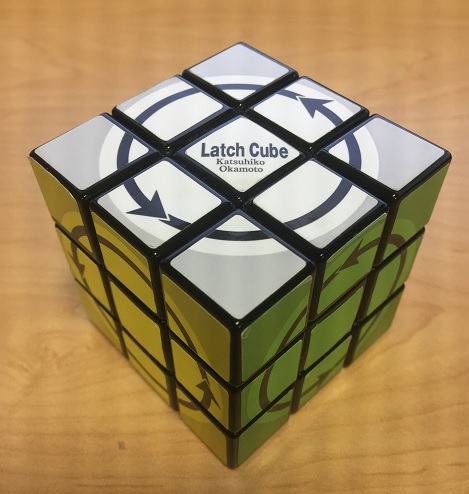

Being the hardest puzzle I have, this one has got to be my favorite. Admittedly, though I have solved this cube several times now, it has always required me to fumble in the dark through a portion of the solve. Unlike every other twisty puzzle I own, I don't have a solution to this puzzle nailed down sufficiently that I could write a computer program to solve it. What I will describe here is a strategy that works best for me.
Note that in these steps, inverses are used freely, even though a face can only rotate both clock-wise and counter-clock-wise if it has no arrows. This should not be confusing for obvious reasons. If a face can rotate at all, then it can effectively rotate both directions.
The main crux is getting the edge cubies into position with proper orientation whenever you can. Make whatever rotations you think necessary, but I've found that edge cubie tri-cycling, when possible, helps preserve what you already have solved. With practice, you can recognize when a tri-cycle of the form A,B,Ai,Bi will go through or not. You have to look at the arrows on the edge cubies concerned, and those on the two faces concerned in the commutator. Often a setup move is useful to unlock faces temporarily, but beware when a setup move cannot be undone! Be ready to back-out your sequence if it won't entirely go through.
The edge-flip sequence in Step 2 of my Rubik's cube solution is most often used as a setup for edge tri-cycling, and does not necessarily need to be undone right away, as positioning the edges is the only objective of this step. The key is realizing that this sequence can always be executed when the 3 pair-wise adjacent faces it involves all show arrows of the same color. You might do a setup move just to insure this conditions before executing the move.
By far this is the hardest step. Often success or failure hinges on simply moving edges in the right order. The Rubik's Cube, on the other hand, has no such restriction. You can move edges in any order, and they eventually land where they need to go. With the Latch Cube, however, order matters. The more you can think ahead, or be able to back-track, the better.
Another successful strategy is to get the white-cross without caring at all about tri-cycling edges. Take whatever moves are available, and continually feel fine about unsolving the white cross as needed to get other edges into the white-cross area. Once you have it, then carefully try to tri-cycle edges while temporarily flipping edges to remove arrow restrictions as necessary.
With all the edge cubies properly positioned, it's time to orient them. I try to reach this step with at most two edge cubies improperly oriented. The case when both such cubies have the same color arrow is easy to solve using a setup move, if needed, in conjunction with the edge-flip sequence in Step 2 of my Rubik's cube solution.
If, on the other hand, both such edge cubies have arrows of differing color, then the matter is much more difficult. The key is to use the edge-flip sequence (already cited twice above), but between two edges with arrows of differing color. This does not have to involve the two misoriented edges in question here, or even one of them. You just need to end up with an even number of black-arrow edges misoriented, and an even number of white-arrow edges misoriented. You can then use the edge-flip sequence (with setups, if needed), to complete this step.
This edge-flip sequence, however, does not go through between two edges of differeing arrow colors. The trick, then, is to perform setup moves before the sequence, mid-sequence, and post-sequence as necessary. The sequence itself is sometimes used as a mid-sequence setup. With practice, you can get good at flipping pairs of edges on a solved latch cube, where both edges are of differing arrow-color.
Note that the term "setup sequence" is being used loosely here, as it is not always necessary that the sequence be undone. You're just moving arrows around temporarily with the intent to go back and fix them in easier cases.
With all edge cubies properly positioned and oriented, the puzzle is now easy to solve. I will sometimes use the sequences in Step 3 of my Rubik's cube solution to get the corner cubies positioned, and I avoid setup moves for fear they may not be undone. You just need to be able to recognize when the commutators will go through before you start them. Interestingly, if the commutator goes through once, it always goes through any number of times. So checking that 3[A,B,Ai,Bi] will go through is only a matter of checking that A,B,Ai,Bi will go through.
An even more convenient sequence is the well-known sequence U,R,Ui,Li,U,Ri,Ui,L and its varients. With practice it is both easy to know when this sequence will go through, and it is easy to find setups for it that are easy to undo.
Variations of 2[Ri,Di,R,D],Ui,2[Di,Ri,D,R],U can then be used to twist two corners at a time. Again, you have to be careful not to start such a sequence unless you know it will go through. Sometimes you have to twist a misoriented corner with an oriented one before you can orient two misoriented corners at the same time. With persistence, the puzzle finally gets solved.
Note that you can use the sequence given in Step 4 of my Rubik's cube solution if it is applied to the 3 pair-wise adjacent faces all sharing the same arrow color.